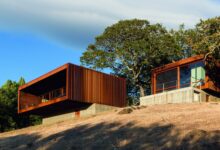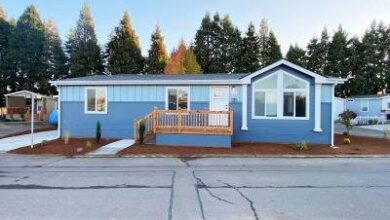Prefab Homes for Sale: Affordable and Sustainable Housing
Prefab Homes for Sale – Are you in the market for a new home that is not only affordable but also environmentally friendly? Look no further than prefab homes for sale! Prefabricated or modular homes have gained popularity in recent years due to their numerous benefits. In this comprehensive guide, we will delve into the world of prefab homes, exploring their unique features, advantages, and the steps involved in purchasing one. Whether you are a first-time buyer or an experienced homeowner, this article will provide you with all the information you need to make an informed decision.
Understanding Prefab Homes
Section 1: What are Prefab Homes?
Summary: Prefab homes, also known as prefabricated or modular homes, are factory-built structures that are constructed off-site and then transported to the final location for assembly. These homes are built in modules or sections, which are then connected to create a complete living space. They differ from traditional stick-built homes, which are constructed entirely on-site.
Subheading 1: Types of Prefab Homes
Summary: There are various types of prefab homes available, each with its own unique characteristics. Some common types include panelized homes, modular homes, and manufactured homes. Panelized homes consist of walls, floors, and roof panels that are built in a factory and then assembled on-site. Modular homes are constructed in modules or sections that are transported to the site and joined together. Manufactured homes, on the other hand, are entirely built in a factory and transported to the site as a complete unit.
Subheading 2: Materials Used in Prefab Homes
Summary: Prefab homes can be constructed using a variety of materials, depending on the type and design of the home. Some common materials include wood, steel, concrete, and SIPs (Structural Insulated Panels). Wood is a popular choice due to its affordability, versatility, and sustainability. Steel is known for its strength and durability, making it ideal for homes in areas prone to natural disasters. Concrete offers excellent thermal insulation and fire resistance. SIPs are energy-efficient panels that consist of a foam core sandwiched between two structural boards.
Subheading 3: Construction Process of Prefab Homes
Summary: The construction process of prefab homes involves several steps, from design and fabrication to transportation and assembly. First, the home is designed according to the buyer’s specifications and needs. Once the design is finalized, the fabrication process begins in the factory, where the various components of the home are constructed. These components are then transported to the final location, where they are assembled and connected to create a complete home. The assembly process typically involves the use of cranes and other heavy machinery.
Benefits of Prefab Homes
Section 2: Cost-Effectiveness of Prefab Homes
Summary: One of the major advantages of prefab homes is their cost-effectiveness. Prefab homes are generally more affordable than traditional stick-built homes due to several factors. The controlled factory environment reduces material waste, and bulk purchasing of materials lowers costs. Additionally, the shorter construction time of prefab homes translates to lower labor costs. Prefab homes also offer the opportunity for customization within a set budget, allowing buyers to choose the features and finishes that suit their needs and preferences.
Subheading 1: Sustainability of Prefab Homes
Summary: Prefab homes are an environmentally friendly housing option. The controlled factory environment allows for better insulation, reducing energy consumption and lowering utility bills. Additionally, prefab homes often incorporate sustainable materials and construction methods. For example, some manufacturers use recycled or sustainable materials, such as reclaimed wood or eco-friendly insulation. Prefab homes can also be designed to be energy-efficient, incorporating features such as solar panels, efficient HVAC systems, and smart home technology.
Subheading 2: Faster Construction Times
Summary: Prefab homes are known for their shorter construction times compared to traditional homes. Since the components of prefab homes are constructed in a factory simultaneously, the construction process is not affected by weather conditions or other external factors. This results in a quicker turnaround time, allowing homeowners to move into their new homes sooner. Faster construction times also mean reduced labor costs and fewer disruptions to the surrounding environment, making prefab homes an efficient and convenient housing option.
Subheading 3: Energy Efficiency of Prefab Homes
Summary: Prefab homes can be designed to be highly energy-efficient, offering long-term savings on utility bills. The controlled factory environment allows for better insulation and sealing, reducing air leakage and heat loss. Additionally, prefab homes can incorporate energy-efficient appliances, LED lighting, and advanced insulation materials. Some manufacturers also offer the option of including renewable energy systems, such as solar panels or geothermal heating, further reducing the home’s carbon footprint and energy consumption.
Finding the Perfect Prefab Home
Section 3: Researching Reputable Manufacturers
Summary: When looking for prefab homes for sale, it is essential to research and choose reputable manufacturers. Take the time to read reviews, visit model homes, and gather information about the manufacturer’s experience, certifications, and customer satisfaction. Look for manufacturers that have a proven track record and a portfolio of successful projects. It is also advisable to check if the manufacturer offers customization options and has a range of floor plans to choose from.
Subheading 1: Exploring Floor Plans
Summary: One of the advantages of prefab homes is the ability to choose from a variety of floor plans. Take the time to explore different layouts and designs that suit your lifestyle and needs. Consider factors such as the number of bedrooms, bathrooms, and living spaces. Evaluate the flow and functionality of the floor plan and envision how it will accommodate your everyday activities and future needs. Some manufacturers offer the flexibility to customize floor plans, allowing you to make modifications to suit your preferences.
Subheading 2: Considering Your Specific Housing Needs
Summary: Before purchasing a prefab home, it is important to consider your specific housing needs. Think about the size of the home, the number of occupants, and any specific requirements or preferences you may have. Consider factors such as accessibility, storage space, and outdoor living areas. Evaluate the location where the home will be placed and the local climate. Taking these factors into account will help you narrow down your options and find the perfect prefab home that meets your unique needs.
Subheading 3: Visiting Model Homes
Summary: Visiting model homes can give you a better understanding of the quality and craftsmanship of the prefab homes offered by a particular manufacturer. Take the opportunity to walk through the model homes, paying attention to the finishes, construction details, and overall design. Assess the quality of the materials used and the attention to detail. This will help you gauge the manufacturer’s commitment to delivering high-quality homes. Don’t hesitate to ask questions and seek clarification on any concerns or doubts you may have.
Financing and Budgeting
Section 4: Obtaining a Mortgage for a Prefab Home
Summary: Financing a prefab home is similar to financing a traditional stick-built home. Start by researching mortgage lenders who specialize in prefab home financing. Consult with lenders to understand the mortgage options available and determine the amount you qualify for. Provide the necessary documentation, including income verification, credit history, and details about the home you intend to purchase. Work closely with the lender to ensure a smooth financing process and secure the best terms and interest rates.
Subheading 1: Calculating Your Budget
Summary: Before purchasing a prefab home, it is important to calculate your budget and understand the costs involved. Consider not only the purchase price of the home but also additional expenses such as site preparation, permits, transportation, and installation. Factor in any customization or upgrades you may want to include. It is also essential to account for ongoing costs such as property taxes, insurance, and maintenance. By accurately calculating your budget, you can ensure that you are financially prepared for the entire process of purchasing and owning a prefab home.
Subheading 2: Costs Associated with Prefab Homes
Summary: In addition to the purchase price of the prefab home, there are several costs associated with prefab homes that need to be considered. Site preparation costs include clearing land, leveling, and utility connections. Permits and inspections are required for construction and compliance with local building codes. Transportation costs vary depending on the distance between the factory and the final location. Installation costs involve crane placement, foundation construction, and joining the modular sections. It is important to obtain detailed quotes from the manufacturer and contractors to accurately estimate these costs.
Subheading 3: Financing Options and Government Incentives
Summary: Explore the various financing options available for prefab homes. In addition to traditional mortgage lenders, some manufacturers offer in-house financing or partnerships with financial institutions. Research government incentives and programs that may be available for prefab homebuyers, such as tax credits or grants. These incentives can help offset the initial costs and make prefab homes even more affordable. Consult with financial advisors or experts to explore all the financing options and incentives that may be applicable to you.
Site Preparation and Building Permits
Section 5: Clearing the Land
Summary: Before the installation of a prefab home, the site needs to be cleared of any vegetation, debris, or obstructions. Clearing the land ensures a clean and level surface for the home’s foundation. Depending on the location and local regulations, you may need to hire professionals to carry out the land clearing process. It is important to consult with the manufacturer and contractors to understand the specific requirements and recommendations for site preparation.
Subheading 1: Leveling theLand
Summary: After clearing the land, the next step in site preparation is leveling. This involves ensuring that the ground is even and stable for the placement of the prefab home. Depending on the terrain and soil conditions, leveling may involve grading, filling, or excavation. It is important to consult with professionals to assess the site and determine the necessary steps for achieving a level surface. Proper leveling is crucial for the stability and longevity of the prefab home.
Subheading 2: Utility Connections
Summary: Before the prefab home can be installed, utility connections need to be established. This includes connecting to electricity, water, and sewer systems. It is important to work with licensed professionals who are familiar with the local regulations and requirements for utility connections. They will ensure that the connections are properly installed and meet all safety and code standards. Coordination with utility providers is also essential to ensure a smooth process and timely completion of the connections.
Subheading 3: Obtaining Building Permits
Summary: Building permits are essential for the installation of a prefab home. The specific requirements for building permits vary depending on the location and local regulations. It is important to research and understand the permit process in your area. Consult with the manufacturer and contractors to gather the necessary documentation and plans required for permit applications. Submit the applications to the appropriate local authorities and ensure compliance with all building codes and regulations. Obtaining the necessary permits ensures that the installation of the prefab home is legal and meets all safety standards.
Delivery and Installation
Section 6: Transportation of Prefab Homes
Summary: Once the site is prepared and permits are obtained, the prefab home is ready for transportation. Depending on the size and design of the home, transportation may involve using trucks, trailers, or even barges for locations near water bodies. The manufacturer will coordinate the transportation logistics, ensuring that the home reaches the final location safely and on schedule. It is important to communicate with the manufacturer and transportation professionals to address any specific requirements or challenges, such as narrow roads or difficult access.
Subheading 1: Crane Placement
Summary: The installation of a prefab home typically involves the use of cranes. Cranes are used to lift and position the modular sections onto the foundation. Proper crane placement is critical for the safe and efficient installation of the home. The manufacturer and contractors will work together to determine the appropriate crane size and placement based on the weight and dimensions of the modules. It is important to have a clear and well-prepared area for crane placement to ensure smooth operation and minimize any potential risks.
Subheading 2: Foundation Construction
Summary: A solid and well-built foundation is essential for the stability and longevity of a prefab home. The type of foundation required will depend on factors such as the local climate, soil conditions, and the design of the home. Common foundation types for prefab homes include concrete slabs, crawl spaces, and basements. The foundation construction process involves excavation, pouring concrete, and installing reinforcement as necessary. Working with experienced contractors is crucial to ensure that the foundation is properly constructed and meets all structural requirements.
Subheading 3: Joining Modular Sections
Summary: Once the foundation is ready, the modular sections of the prefab home are ready to be joined together. This process involves aligning the sections and securely connecting them to create a complete living space. The manufacturer’s team, along with contractors, will work together to ensure that the sections are properly aligned and fastened. It is important to follow the manufacturer’s guidelines and recommendations for joining the sections to ensure structural integrity and minimize any potential issues or gaps.
Interior and Exterior Finishes
Section 7: Choosing Interior Finishes
Summary: One of the exciting aspects of purchasing a prefab home is the opportunity to customize the interior finishes. From flooring and cabinetry to fixtures and appliances, you can choose the materials and designs that reflect your personal style and preferences. Consider factors such as durability, maintenance requirements, and aesthetics when selecting interior finishes. Consult with the manufacturer or work with interior designers to explore the various options available and create a cohesive and inviting living space.
Subheading 1: Flooring Options
Summary: Flooring is a significant component of the interior finishes in a prefab home. There are various flooring options to choose from, including hardwood, laminate, tile, and vinyl. Each material has its own unique characteristics and advantages. Consider factors such as durability, ease of maintenance, and aesthetic appeal when selecting flooring for different areas of the home. It is also important to consider the compatibility of the flooring material with the heating and cooling systems in the home.
Subheading 2: Cabinetry and Countertops
Summary: Cabinetry and countertops play a crucial role in both the functionality and aesthetics of a prefab home. Choose high-quality materials and finishes that align with your style preferences and offer durability. Consider factors such as storage needs, ease of maintenance, and the overall design theme when selecting cabinetry and countertops. Customization options, such as different wood species, finishes, and hardware, allow you to create a personalized and functional kitchen and other storage areas in the home.
Subheading 3: Fixtures and Appliances
Summary: Fixtures and appliances are essential components of a functional and comfortable living space. Select high-quality fixtures such as faucets, sinks, and lighting fixtures that not only enhance the overall design but also offer durability and efficiency. When choosing appliances, consider energy efficiency ratings, functionality, and the specific needs of your household. Consult with the manufacturer or work with interior designers to ensure that the fixtures and appliances are compatible with the overall design and meet all necessary specifications.
Post-Installation Considerations
Section 8: Inspections and Certificates of Occupancy
Summary: After the installation of the prefab home, it is important to complete inspections and obtain certificates of occupancy. Inspections ensure that the home meets all building codes and safety standards. Depending on the location, inspections may be required for electrical, plumbing, and structural components. Once all inspections are successfully completed, the local authorities will issue a certificate of occupancy, allowing you to legally occupy and live in the prefab home.
Subheading 1: Moving In and Settling
Summary: After obtaining the necessary certificates of occupancy, it’s time to move into your new prefab home. Plan and coordinate the logistics of the move, ensuring that utilities are connected and any necessary arrangements are made. Take the time to settle into your new home, unpacking and organizing your belongings. Familiarize yourself with the features and functions of the home, such as heating and cooling systems, appliances, and security features. Enjoy the process of making your prefab home your own and creating a comfortable living space.
Subheading 2: Connecting Utilities
Summary: Connecting utilities is an important post-installation consideration. Ensure that all necessary utility connections, such as electricity, water, and sewer, are properly installed and functioning. Coordinate with utility providers to have services activated and metered. Test the functionality of all utilities and address any issues or concerns promptly. It is also advisable to set up any additional services such as internet, cable, or phone connections as required.
Subheading 3: Homeowner’s Maintenance Responsibilities
Summary: As a homeowner, it is important to understand and fulfill maintenance responsibilities to ensure the longevity and performance of your prefab home. Regular maintenance tasks include cleaning, inspecting, and repairing as necessary. Develop a maintenance schedule and checklist to stay on top of routine tasks such as HVAC filter changes, gutter cleaning, and roof inspections. It is also important to address any repairs or issues promptly to avoid further damage. Regular maintenance will help preserve the value and functionality of your prefab home.
Maintenance and Upkeep
Section 9: Cleaning and Care
Summary: Regular cleaning and care are essential for maintaining the appearance and functionality of your prefab home. Develop a cleaning routine that includes tasks such as dusting, vacuuming, mopping, and surface cleaning. Pay attention to specific materials and finishes in your home and use appropriate cleaning methods and products. Regular cleaning not only keeps your home looking its best but also helps prevent the build-up of dirt, dust, and allergens.
Subheading 1: Inspecting and Repairing
Summary: Regular inspections and prompt repairs are crucial for identifying and addressing any issues before they escalate. Inspect the interior and exterior of your prefab home periodically, paying attention to areas such as the roof, walls, windows, and plumbing. Look for signs of damage, wear and tear, or any potential maintenance needs. Address any repairs promptly to prevent further damage and maintain the integrity of your home. Consult with professionals if you are unsure about the severity or complexity of a repair.
Subheading 2: Maintaining Energy Efficiency
Summary: Energy efficiency is a key aspect of prefab homes. To maintain the energy efficiency of your home, pay attention to factors such as insulation, windows, and appliances. Ensure that insulation is intact and properly installed to prevent energy loss. Regularly clean and maintain windows to ensure proper sealing and minimize drafts. Service and maintain appliances and HVAC systems according to manufacturer recommendations to ensure optimal performance and energy efficiency. Consider upgrading to energy-efficient appliances or installing smart home technology to further enhance energy efficiency.
Subheading 3: Future Upgrades and Expansions
Summary: Prefab homes offer the flexibility for future upgrades and expansions. As your needs change or new technologies become available, you can consider upgrading and expanding your prefab home. Whether it’s adding additional modules or incorporating new features and finishes, consult with professionals to ensure that any upgrades or expansions are structurally sound and comply with building codes. Keep up with industry trends andresearch to explore the latest innovations and possibilities for upgrading your prefab home. Regularly assess your needs and consider how your home can evolve to meet them.
The Future of Prefab Homes
Section 10: Technological Advancements in Prefab Homes
Summary: The prefab home industry is constantly evolving, driven by technological advancements. From advanced design software to robotic manufacturing processes, technology is revolutionizing the way prefab homes are designed and built. Explore the latest technological advancements and their impact on prefab homes, such as 3D printing, virtual reality design tools, and smart home integration. Stay informed about emerging technologies to envision the possibilities for the future of prefab homes.
Subheading 1: Sustainable Innovations
Summary: Sustainability is a growing focus in the prefab home industry. Manufacturers are increasingly incorporating sustainable materials and construction methods into their designs. Stay updated on the latest sustainable innovations, such as eco-friendly insulation, solar energy systems, and rainwater harvesting. Explore how these innovations can enhance the sustainability of your prefab home and reduce your carbon footprint.
Subheading 2: Customization and Design Flexibility
Summary: Prefab homes are becoming more customizable and flexible in design. Manufacturers are offering a wider range of options for finishes, layouts, and architectural styles. Embrace the possibilities for customization and design flexibility in prefab homes, allowing you to create a home that truly reflects your unique tastes and lifestyle. Keep an eye on emerging trends in interior and exterior design to stay ahead of the curve.
Subheading 3: Increased Affordability and Accessibility
Summary: As the prefab home industry continues to grow and evolve, affordability and accessibility are becoming key considerations. Manufacturers are finding ways to make prefab homes more affordable and accessible to a wider range of buyers. This includes exploring cost-effective construction methods, streamlining processes, and collaborating with financial institutions to offer competitive financing options. Stay informed about these developments to take advantage of the increasing affordability and accessibility of prefab homes.
In conclusion, prefab homes offer an affordable, sustainable, and customizable housing solution for individuals and families alike. By understanding the unique features, benefits, and steps involved in purchasing and maintaining a prefab home, you can make an informed decision that suits your needs and budget. Take the first step towards your dream home today by exploring the wide range of prefab homes for sale. Embrace the future of housing with prefab homes and enjoy the benefits of affordability, sustainability, and design flexibility.









